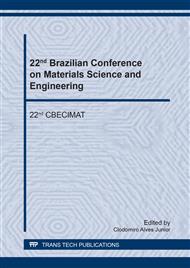p.26
p.32
p.37
p.43
p.48
p.53
p.57
p.63
p.67
Characterization of Biomaterial and Tissue Response Analysis after Implantation
Abstract:
Some biomaterials can be used to promote tissue repair process. The biological substitutes (biomaterials such as hydroxyapatite beads) can be used with some advantages and purpose of mimicking responses to on-site repair of the injured bone. The objective of this study was to evaluate the osteogenic potential of the biomaterial composed of hydroxyapatite and alginate in place of the critical defect. bioceramic samples stoichiometric hydroxyapatite was produced by the precipitation method, wet method with ion molar ratio of Ca 10 (PO 4) 6 (OH) 2, in which the Ca / P ratio was equal to 1.67. The reaction conditions were favorable to the composition of a biomaterial with crystalline phase. The synthesis of the biomaterial composed of hydroxyapatite and alginate microspheres (HAAlg5%; 200 ø 425mm) was obtained from two primary solutions with the aim of, in optimal reactive conditions, to form the precipitate. After synthesis the microspheres were implanted into the defect site. The potential effects of using HAAlg5% and the application of vibratory waves in the critical defect repair were unknown and the results described in this study are promising, considering the systemic therapy and at the site of injury. The biomaterial used promoted repair the injured tissue.
Info:
Periodical:
Pages:
48-52
Citation:
Online since:
September 2018
Price:
Сopyright:
© 2018 Trans Tech Publications Ltd. All Rights Reserved
Share:
Citation:


